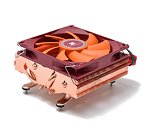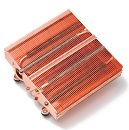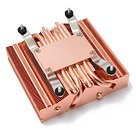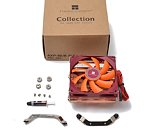- Joined
- Oct 9, 2007
- Messages
- 47,886 (7.38/day)
- Location
- Dublin, Ireland
| System Name | RBMK-1000 |
|---|---|
| Processor | AMD Ryzen 7 5700G |
| Motherboard | Gigabyte B550 AORUS Elite V2 |
| Cooling | DeepCool Gammax L240 V2 |
| Memory | 2x 16GB DDR4-3200 |
| Video Card(s) | Galax RTX 4070 Ti EX |
| Storage | Samsung 990 1TB |
| Display(s) | BenQ 1440p 60 Hz 27-inch |
| Case | Corsair Carbide 100R |
| Audio Device(s) | ASUS SupremeFX S1220A |
| Power Supply | Cooler Master MWE Gold 650W |
| Mouse | ASUS ROG Strix Impact |
| Keyboard | Gamdias Hermes E2 |
| Software | Windows 11 Pro |
Thermalright rolled out the AXP-90 Full Copper top-flow CPU cooler for low-profile PC builds. A smaller sibling of the AXP-100 Full Copper, and a variant of the aluminium-based original AXP-90, this cooler features a dense copper fin-stack that's arranged along the plane of the motherboard. Four 6 mm-thick copper heat pipes make indirect contact with the CPU over a mirror-finish copper base-plate, pulling heat through the fin-stack. A 15 mm-thick 92 mm TL-9015R fan ventilates the fin-stack. This fan takes in 4-pin PWM input, spins at speeds of up to 2,700 RPM, pushing up to 42.58 CFM of air, with as low as 22.4 dBA of noise output. With the fan in place, the AXP-90 Full Copper measures 97 mm x 92 mm x 47 mm (WxDxH), weighing 490 g. There are two sub-variants of the cooler specific to CPU socket type supported, the AXP-90 Full Copper LGA115X, and AXP-90 Full Copper AM4. Available on Chinese e-tailers such as T-Mall, the AXP-90 Full Copper is priced at RMB 299, or the equivalent of USD $42.70.




View at TechPowerUp Main Site




View at TechPowerUp Main Site






